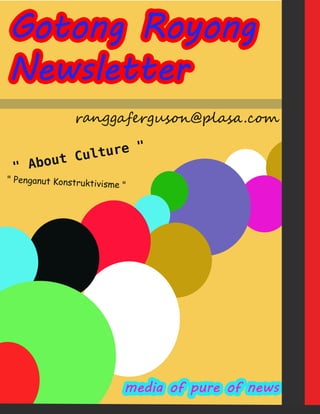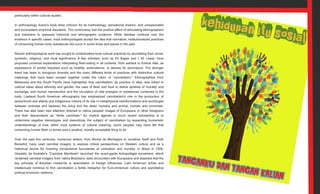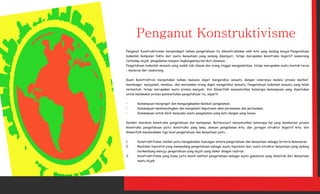News 2
- 1. e " t Cultur " Abou " Penganut Konstruktiv isme "
- 2. The possibility of cannibalism has been an object of thought and imagination in virtually every society. The western cultural human culture in it politically sensitive. Since the 1 970s, especially in the United States, anthropologists and historians have debated where and to idea of consuming human body substance as food or for what extent cannibalism was an institutionalized, socially accepted symbolic purposes invokes emotionally charged cultural practice (as distinguished from its occurrence as an aberrant, and psychological concerns with boundaries between individual act motivated by starvation or psychological deviance). self and other, persons and nonpersons, the meanings These arguments mostly involved historical and retrospective of food and ingestion, and the limits of a moral evidence, since under the impact of colonialism and modernity, any community. Many societies, both Western and non- former practices of institutionalized flesh-eating had largely Western, have seen cannibalism as a marker of disappeared by the 1 970s. Major controversies focused on Michael negative difference between peoples, a quintessential Harner's and Marvin Harris's interpretation of human sacrifice as a symbol of otherness, savagery, and subhumanity. response to dietary shortages among the Aztecs of fifteenth- Others have treated it as a form of exchange or as a century Mexico; the role of funerary cannibalism in epidemics of the mechanism of transformation, regeneration, or neurological disease kuru in the New Guinea highlands; the reproduction through transactions between ontological ongoing debate between Marshall Sahlins and Gananath categories such as kin and enemy, mortals and deities, Obeyesekere over allegations of cannibalism among South Pacific human and animal. islanders and after the death of Captain James Cook; and the interpretation of archaeological finds from Europe and the In Western thought, two uses of the idea of cannibalism southwestern United States that show dismemberment, mutilation, have been recurring themes: as a negative stereotype and cooking of body parts. of exotic "others," and as a metaphor for reflexive questioning, critique, and parody of Western culture. A major impetus to debates over the reality of cannibalism came Especially in the politics of colonialism, accusations of from William Arens's The Man-Eating Myth (1 979), which examined cannibalism have been deployed to denigrate non- selected accounts from some non-Western societies. Finding a lack Western peoples, assert colonizers' moral superiority, of hard evidence and no credible eyewitness accounts by Western and legitimize the takeover of native lives and lands. experts, Arens expressed doubt that cannibalism ever existed Only recently have scholars called attention to socially anywhere as a socially approved practice. He argued that approved cannibal practices in Western history, such as cannibalism is best understood not as a cultural practice but as a the tradition of using human body substances as projection of Western fantasies, racism, and political propaganda. medicines, which flourished in Europe until the Although presented as a critique of Orientalist prejudices, the eighteenthcentury. argument reified negative colonial stereotypes with its implicit assumption that the act of ingesting human substance is in all The stigma associated with cannibalism in Western cases repulsive and morally indefensible. Arens's critique of the thought makes any assertion that certain people engaged supposed bias and credulity of those who have written about in it politically sensitive. Since the 1 970s, especially in the cannibalism as social practice found some scholarly receptivity,
- 3. particularly within cultural studies. In anthropology, Arens's book drew criticism for its methodology, sensational rhetoric, and unreasonable and inconsistent empirical standards. The controversy had the positive effect of stimulating ethnographers and historians to reassess historical and ethnographic evidence. While debates continue over the evidence in specific cases, most anthropologists accept the idea that normative, institutionalized practices of consuming human body substances did occur in some times and places in the past. Recent anthropological work has sought to contextualize local cultural practices by elucidating their social, symbolic, religious, and ritual significance. A few scholars, such as Eli Sagan and I. M. Lewis, have proposed universal explanations interpreting flesh-eating in all contexts, from warfare to funeral rites, as expressions of similar impulses such as hostility, ambivalence, or desires for dominance. The stronger trend has been to recognize diversity and the many different kinds of practices with distinctive cultural meanings that have been lumped together under the rubric of "cannibalism." Ethnographies from Melanesia and the South Pacific have highlighted how cannibalism, as practice or idea, was linked to cultural ideas about ethnicity and gender, the uses of flesh and food to define spheres of morality and exchange, and human reproduction and the circulation of vital energies or substances contained in the body. Lowland South American ethnography has emphasized cannibalism's role in the production of personhood and alterity and indigenous notions of its role in metaphysical transformations and exchanges between enemies and between the living and the dead, humans and animal, mortals and immortals. There has also been new attention directed to native peoples' images of Europeans or other foreigners and their descendants as "white cannibals." An implicit agenda in much recent scholarship is to undermine negative stereotypes and deexoticize the subject of cannibalism by expanding humanistic understandings of how, within local systems of cultural meaning, some peoples may have felt that consuming human flesh or bones was a positive, morally acceptable thing to do. Over the past five centuries, numerous writers, from Michel de Montaigne to Jonathan Swift and Ruth Benedict, have used cannibal imagery to express critical perspectives on Western culture and as a rhetorical device for inverting conventional boundaries of civilization and morality. In Brazil in 1 928, Oswaldo de Andrade's "Cannibal Manifesto" launched the avant-garde Antropofagia movement, which reclaimed cannibal imagery from native Brazilians' early encounters with Europeans and asserted that the key principle of Brazilian modernity is assimilation of foreign influences. Latin American artists and intellectuals continue to find cannibalism a fertile metaphor for Euro-American culture and exploitative political economic relations.
- 4. Penganut Konstruktivisme berpendapat bahwa pengetahuan itu dikonstruksikan oleh kita yang sedang beajar.Pengetahuan bukanlah kumpulan fakta dari suatu kenyataan yang sedang dipelajari, tetapi merupakan konstruksi kognitif seseorang terhadap objek, pengalaman maupun lingkungannya.berikut ulasanya: Pengetahuan bukanlah sesuatu yang sudah ada disana dan orang tinggal mengambilnya, tetapi merupakan suatu bentuk terus ¿C menerus dari seseorang. Kaum Konstruktivis menyatakan bahwa manusia dapat mengetahui sesuatu dengan inderanya melalui proses melihat, mendengar, menjamah, membau, dan merasakan orang dapat mengetahui sesuatu. Pengetahuan bukanlah sesuatu yang telah terbentuk, tetapi merupakan suatu proses menjadi. Von Glaserfelk menyebutkan beberapa kemampuan yang diperlukan untuk melakukan proses pembentukan pengetahuan itu, seperti: ? Kemampuan mengingat dan mengungkapkan kembali pengalaman, ? Kemampuan membandingkan dan mengambil keputusan akan persamaan dan perbedaan, ? Kemampuan untuk lebih menyukai suatu pengalaman yang satu dengan yang lainya. Kendati demikian konstruksi pengetahuan dan batasanya. Bettencourt menyebutkan beberapa hal yang membatasi proses konstruksi pengetahuan yaitu: konstruksi yang lama, domain pengalaman kita, dan jaringan struktur kognitif kita. Von Glaserfelk membedakan tiga level pengetahuan dan kenyataan yaitu : 1. Konstruktifisme radikal yaitu mengabaikan hubungan antara pengetahuan dan kenyataan sebagai kriteria kebenaran 2. Realisme hipotetik yang memandang pengetahuan sebagai suatu hipotesis dari suatu struktur kenyataan yang sedang berkembang menuju pengetahuan yang sejati yang dekat dengan realitas 3. Konstruktifisme yang biasa yaitu masih melihat pengetahuan sebagai suatu gambaran yang dibentuk dari kenyataan suatu objek




